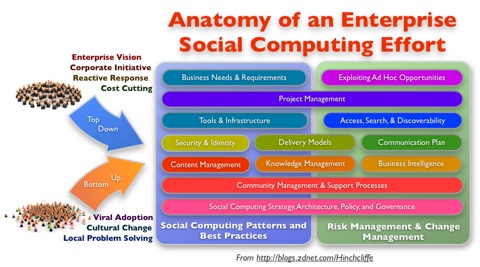Going beyond the hype: Identifying Enterprise 2.0 best practices

There's been plenty of discussion recently in the blogosphere, including here, about the successes and challenges of Enterprise 2.0 projects. But there's still just a rough general sense of what it really takes to create an effective collaborative community using social tools.
It's starting to become clear that successful Enterprise 2.0 efforts have community management as a core function. Stewart Mader's guest post this week on Dennis Howlett's blog here on ZDNet helps tell part of this story: As businesses go about their daily activities, they aren't looking for either Enterprise 2.0 or a social tool like a wiki for its own sake. Instead, they are looking to solve problems and meet their deadlines in easier, cheaper, and better ways. To the extent that social computing can help do this, it will remain a topical subject in business and IT. To the extent that it's a distraction, a risk, or more overhead, it won't.
Those trying to read the tea leaves about Enterprise 2.0 these days can see that the software at least has arrived in a bare majority of companies, even if it's just Facebook or Twitter across the firewall. Genuine adoption and meaningful integration into business processes has certainly happened in a number of organizations, but is still the edge case today rather than the rule. That's not to say the current case studies aren't reporting gains, they generally are. But the message here is that many enterprises are now actively in full contact with the social computing world, whether they want to or not, and now it's time to understand how to deal with the benefits and issues.
What does seem to be emerging are the first broad outlines of a body of knowledge on how to make social computing work in a business setting. So-called best practices and effective techniques are beginning to be identified and understood. And if one accepts that some level of adoption of social tools is inevitable in most workplaces (just not that big an "if" these days), then understanding how to manage the upside while dealing with any potential downsides of Enterprise 2.0 just makes good business sense.
Emerging best practices in social software
The last couple of years has seen a steady, conscious effort to collect and codify social computing techniques and best practices. These include:
- Andrew McAfee's attempt to create a pattern language for Enterprise 2.0.
- Stewart Mader's excellent Wikipatterns.
- Sun's well produced Social Software Pattern Language.
- The social patterns captured in Designing Social Interfaces by Christian Crumlish and Erin Malone and probably best summarized here.
But while these efforts are laudable and often extremely useful when designing social software or structuring online communities, they often lack what I like to call "enterprise context". Enterprise context represents all of the issues that any effort do something requires in a business setting. Whether it's an allocated budget, executive sponsorship, clear understanding of business needs, security requirements, corporate mandate, project planning, communication, compliance or a dozen other overarching issues that touch upon and color every business and IT initiative, enterprise context is the operating environment within which Enterprise 2.0 and other social computing initiatives must effectively work.
As a new approach to communication and collaboration amongst workers, partners, and customers, Enterprise 2.0 brings some new issues to the enterprise context table as well. For the most part, these are unexciting issues for most social software evangelists, so you won't often hear about them, but absolutely necessary ones to deal with forthrightly if efforts are to succeed. There are also some genuinely important aspects of Enterprise 2.0 which hold both considerable promise while simultaneously making traditional managers a bit uncomfortable when they think about how much change it could ultimately entail, as we'll see below.
Related: Online community software market set to take off.
Ross Dawson has done a good job recently on the subject of Enterprise 2.0 methodologies with his Enterprise 2.0 implementation framework. As good as it is, it doesn't emphasize what seems to be emerging as ground zero issues around risk, control, and trust with Enterprise 2.0. These are some of the key issues that will have to be managed most closely in any major social computing effort.
Six key issues Enterprise 2.0 best practices must address
Distilling the usable techniques from a methodology should provide strategies that will helpful in a particular context. When looking at the use of Enterprise 2.0 in the modern workplace to solve problems, these items seem to stand out as the top issues that any set of social computing best practices should address:
- Reconciling top-down with bottom-up efforts. There are still mixed signals coming from existing case studies and practitioner reports, but it's apparent that many more ad hoc departmental, grassroots efforts are now being faced internally with a growing number of enterprise-wide efforts. How they will deconflict -- and indeed, seeing that many of the successes are due to a combination of the two -- how they will jointly succeed is something that effective best practices must provide concrete guidance.
- Cost reduction. We're continuing to see signs that there is interest in replacing larger enterprise systems with lighter weight Web 2.0 alternatives at a fraction of the cost of their enterprise-class predecessors, even if they don't have exactly the same functionality. Enterprise 2.0 solutions, depending on their feature set, are becoming candidates to replace existing document management and knowledge management systems, enterprise portals, and even larger enterprise suites such as CRM systems. While rip-and-replace isn't yet happening on a large scale, using Enterprise 2.0 for conscious cost-reduction is a new emerging trend. For now, it must be explored further and potential causes for disruption and dislocation of existing data and business processes identified and dealt with.
- Risk. For many types of business activities, the risks of social tools for many organizations is that information goes out over the network in a way that can't be controlled or rolled back. That more knowledge is created by more people and that it is sometimes harder to judge which is authoritative and accurate is also another risk factor. There are numerous others. In general, Enterprise 2.0 is considered a riskier way of doing things that using existing hierarchical or bureaucratic processes. There are a growing number of ways to mitigate this including automated moderation, reputation systems, and other approaches but best practices must be developed to deal with this in an explicit manner. Rightly or wrongly, it's fair to say that risk is one of the top issues with Enterprise 2.0 in many business settings and addressing it will be a priority for many efforts.
- Control. Much has been made about the control issues of Enterprise 2.0, probably most succinctly by Andrew McAfee who noted recently that:
"[C]ertain E2.0 enthusiasts adopt the language of revolutionaries. They rail against the old corporate order and proclaim that they’re working for its downfall. They portray hierarchy, standardization, and management as enemies of innovation, creativity, and value creation. And they maintain that E2.0 is an unstoppable force that will only gain power as Millennials enter the workforce and that resistance to it is, ultimately, futile.
He notes that this view is unhelpful and wrong. Nevertheless there are control issues that can emerge as departmental, project, and organizational barriers intentionally become more porous, information flows increase, and control can be accidentally or intentionally usurped -- for better or worse -- by whomever is willing to work together and collaborate. - Trust. It wasn't long ago that e-mail was viewed with suspicion and even relatively mature technologies such as instant messaging and chat systems are still looked at with some skepticism. Questions like these are common: Will having new channels to communicate and collaborate waste worker's time? Will employees use social tools intelligently, especially in public? Will they know how to make the most of them? Are social models for collaboration really better than less social ones already in place? Can I routinely rely on the results produced by them? These and many other trust issues must be addressed by any supposed set of Enterprise 2.0 best practices.
- Community management. This has become a topic of discussion in the Enterprise 2.0 community, with some not believing community management to be necessary and others finding it essential. At this point, it's starting to become clear that successful Enterprise 2.0 efforts have community management (the art and science of nurturing, supporting, maintaining and guiding an online group of participants) as a core function that drives successful outcomes. In my next post I'll be presenting some early data from a survey of active Enterprise 2.0 projects about the needs and requirements of community management
Identifying Enterprise 2.0 best practices
As part of this discussion on best practices, I am currently researching existing Enterprise 2.0 methodologies from a number of sources, focusing especially on the enterprise context discussed above. I'll be collating the results, mining them for best practices, and presenting the outcome at this fall's Enterprise 2.0 Conference West in San Francisco on the morning of Day 2 (November 4th). I'll also summarize the findings in detail here afterwards.
If you have collected your best practices together or put them into a framework or methodology, I'd love to hear about your findings to help us get a full picture of how to address the opportunities and challenges of Enterprise 2.0 this year.
Update: Ross Dawson responds about Enterprise 2.0 best practices.
What are the biggest issues with Enterprise 2.0 this year in your mind?
